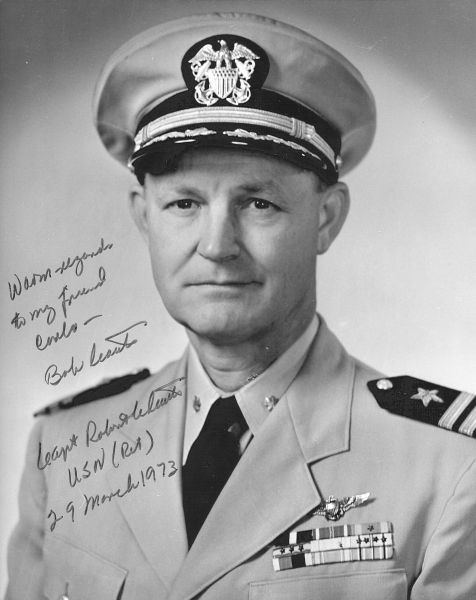Coats, Robert Charles "Bob"
- Date of birth:
- January 2nd, 1918
- Date of death:
- July 7th, 2011
- Buried on:
- Florida National Cemetery
Plot: 307. Grave: 31. - Service number:
- 0-84308
- Nationality:
- American
Biography
Robert Charles Coats entered service from August 13th, 1940 and received his designation on June 23rd, 1941.
During his service in the Second World War, Robert Coats was credited for shooting down 9.33 enemy planes in 131 combat missions.
After the Second World War he was also awarded the Legion of Merit.
Career:
13th August 1940 - 23rd June 1941: Flight Training, NAS Pensacola, Opa Locka, Florida;
23rd June 1941 - August 1941: Primary Instructor School, Corry Field, Pensacola, Florida;
August 1941 - February 1942: Primary Instructor TS-11C, Rodd Field, Corpus Christi, Texas;
February 1942 - July 1943: Advanced Instructor TS-14, NAS Corpus Christi, NAS Kingsville;
August 1943 - October 1943: Fighting Squadron 18 (VF-18), NAS Alameda, NAS North Island;
1st October 1943 - 1st March 1944: Fighting Squadron 18 (VF-18), U.S.S. Bunker Hill;
1st March 1944 - 1st December 1944: Fighting Squadron 17 (VF-17), NAS Alameda, Hilo, Guam, Ulithi;
2nd December 1944 - 5th June 1945: Operations Officer Fighting Squadron 17 (VF-17), U.S.S. Hornet;
August 1945 - September 1945: NAS Alameda, California;
September 1945 - June 1946: NAS Corpus Christi, Operations Division, OIC Aircraft Acceptance and Transfer Unit;
June 1946 - July 1948: Acting Assitant Director Armament Test Division, NATC Patuxent River, Class Zero, USN Test Pilot Training, Coordinator of Tests Projects;
September 1948 - October 1948: Air Group 4;
1st October 1948 - 5th June 1949: Commanding Officer Fighting Squadron 43 (VF-43) ,U.S.S. Franklin D. Roosevelt, NAS Jacksonville;
June 1949 - December 1949: Navy Hospital Jacksonville, Florida;
December 1949 - June 1950: COMFAIRJAX;
10th June 1950 - 31st December 1951: Commanding Officer Fighting Squadron 14 (VF-14), NAS Jacksonville, U.S.S. Wright, U.S.S. Saipan, U.S.S. Cabot, U.S.S. Siboney, U.S.S. Kula Gulf (CVE-108), U.S.S. Oriskany;
January 1952 - December 1952: Navy General Line School, Monterey, California;
February 1953 - April 1955: Staff COMOPDEV FOUR, NAS Norfolk, Air Department, Monitor of VX-3 NAS Atlantic City;
May 1955 - August 1957: BuAir Armament Division;
September 1957 - October 1958: Operations Officer U.S.S. Lake Champlain;
October 1958 - September 1959: VAAW-33, X.O, NAS Quonset Point, RI;
1st October 1959 - 1st August 1960: Commanding Officer VAAW-33;
August 1960 - June 1961: Industrial College Armed Forces, Washington, D.C.;
June 1961 - July 1964: Brnach Head Navy Department R&D Division;
July 1964 - June 1967: Commanding Officer Navy Station Chaguaramus, Trinidad;
July 1967 - July 1970: FL. Assistant Chief of Staff for Operations, Director of Training CNATRA, NAS Pensacola;
July 1970 - November 1970: Branch Head Southeast Asia Region, Plans and Programs Division The Strike Command, McDill Air Force Base, Tampa Florida;
November 1970 - February 1971: Navy Hospital, NAS Jacksonville, Florida;
February 1971: Retirement.
Do you have more information about this person? Inform us!
- Period:
- Second World War (1939-1945)
- Rank:
- Lieutenant
- Unit:
- Fighting Squadron 17 (VF-17), U.S.S. Hornet (CV-12), U.S. Navy
- Awarded on:
- July 2nd, 1945
"For extraordinary heroism in operations against the enemy while serving as Pilot of a carrier-based Navy Fighter Plane in Fighting Squadron SEVENTEEN (VF-17), attached to the U.S.S. HORNET (CV-12), in operations against the enemy during a fighter plane sweep over southern Kyushu, Japan, on 18 March 1945. Flying as leader of a division of carrier-based fighters, Lieutenant Coats personally destroyed five enemy planes during the flight. He shot down one enemy plane in flames as it pursued a fellow pilot. Shortly thereafter five more enemy fighters were observed, flying in echelon formation. He closed to the rear of this flight and, with three short bursts, dropping his left wing and turning slightly to the left each time, destroyed three of the planes, one exploding in the air and the others flaming at the wing roots and crashing. Later during the same flight he sighted two enemy fighters pursuing one of our planes. He fired on one of the planes whose pilot bailed out when part of a wing flew off. His outstanding courage and determined skill were at all times inspiring and in keeping with the highest traditions of the United States Naval Service."
Commander 1st Carrier Task Force Pacific: Serial 0614 (July 2, 1945).
- Period:
- Second World War (1939-1945)
- Rank:
- Lieutenant
- Unit:
- Fighting Squadron 17 (VF-17), U.S.S. Hornet (CV-12), U.S. Navy
- Period:
- Second World War (1939-1945)
- Rank:
- Lieutenant
- Unit:
- Fighting Squadron 17 (VF-17), U.S.S. Hornet (CV-12), U.S. Navy
- Period:
- Second World War (1939-1945)
- Period:
- Second World War (1939-1945)
- Period:
- Second World War (1939-1945)
Sources
- Photo 1: Bill Gonyo
- - Sterner C.D., Recipients of The Navy Cross, 1916 - Present
- Military Times Hall of Valor
- Home of Heroes







